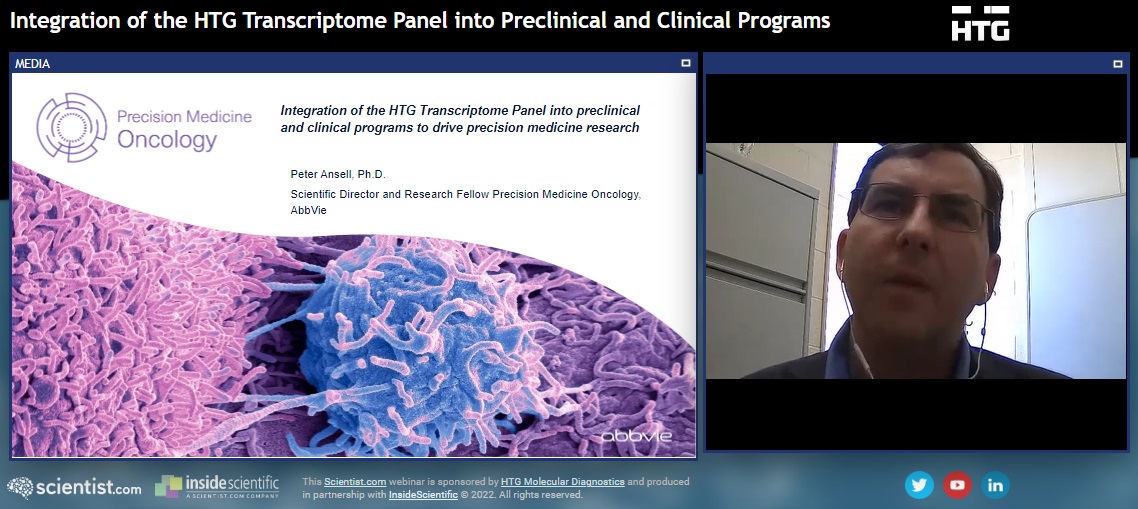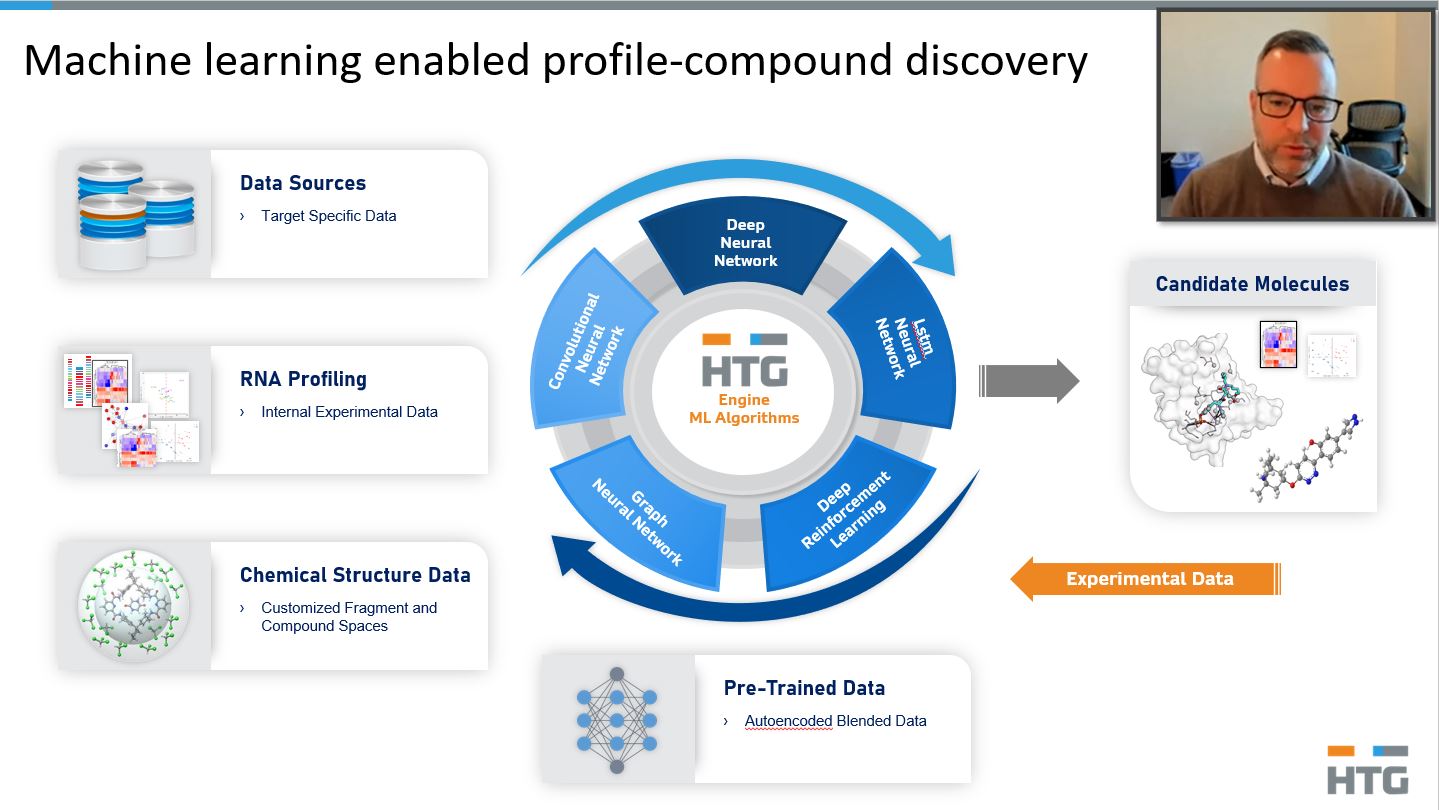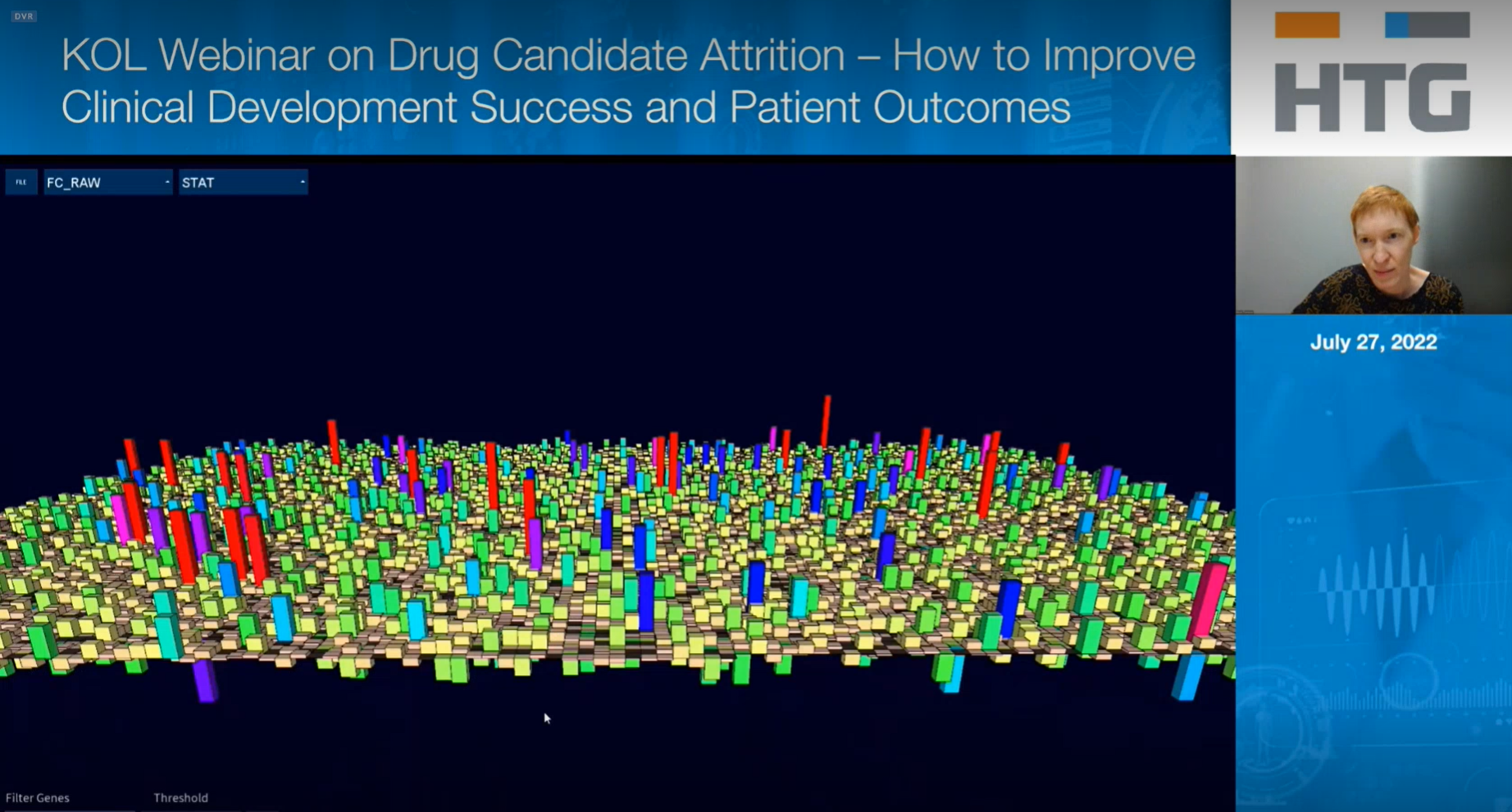
Resources
Webinars
Presenters : Dr. Leonie Frauenfeld and Sebastian Streich
Institution: University of Tubingen, Germany
Originally aired on: Wednesday, May 24, 2023
Diffuse large B-cell lymphomas in adults with aberrant coexpression of CD10, BCL6, and MUM1 are enriched in IRF4 rearrangements
by Dr. Leonie Frauenfeld
Diffuse large B-cell lymphoma (DLBCL) with aberrant coexpression of CD10+BCL6+MUM1+ (DLBCL-AE), classified as germinal center B cell (GCB) type by the Hans algorithm (HA), was genetically characterized. To capture the complexity of DLBCL-AE, collaborators used an integrated approach that included two different gene expression profiling (GEP) systems (HTG, EdgeSeq DLBCL Cell of Origin Assay and NanoString, Lymph2Cx assay), fluorescence in situ hybridization, targeted gene sequencing, and copy number (CN) arrays. The collaborators found that DLBCL-AE are genetically heterogeneous and enriched in cases with IRF4 alterations. The correlation between the 2 different GEP assays was very good, no discordant cases were classified as GCB or ABC, 5 unclassifiable cases in Lymph2Cx were classified as either ABC or GCB in HTG EdgeSeq. The LBCL-IRF4 in adults has many similarities to the pediatric counterpart, this entity is described as a definitive entity in both the International Consensus Classification of Mature Lymphoid Neoplasms and the 5th edition of the WHO Classification of Tumors of Hematopoietic and Lymphoid Tissues.
Prevalence of IRF4 rearrangement in large B-cell lymphomas of the Waldeyer's ring in adults
by Sebastian Streich
Diffuse large B-cell lymphoma (DLBCL) is the most common B-cell non-Hodgkin lymphoma in adults. Recent studies have suggested new subtypes of large B-cell lymphoma, based on genetic and molecular alterations, including the large B-cell lymphoma with IRF4-rearrangement (LBCL-IRF4), which are defined as a definite entity in the International Consensus Classification of Mature Lymphoid Neoplasms and in the 5th edition of the WHO Classification of Tumours of Hematopoietic and Lymphoid Tissues. We used fluorescence in situ hybridization (FISH), gene expression profiling (GEP) (HTG, EdgeSeq DLBCL Cell of Origin Assay), and next-generation sequencing (NGS) to comprehensively characterize LBCLs located in Waldeyer’s ring in adult patients and to identify cases of LBCL-IRF4.
- Category:
- Webinars
Transcriptome-Wide GEP Profiles Reveal Different Patterns Between Synovial Sarcomas and Morphologic Mimickers
Presenters : Dr. Sabrina Borchert
Institution: University Hispital Essen, Germany
Originally aired on: Friday, March 3, 2023
The ability to tailor treatment for individual cancer patients is one of the most pivotal goals of oncology precision medicine. To accomplish this, scientists must translate the biology driving each patient’s tumor in order to assess the risk of morbidity and mortality and identify an optimized plan for the best possible outcomes. In this webinar, Dr. Sabrina Borchert will discuss how she and her team tested the robustness and the reliability of a novel quantitative nuclease protection assay (HTG Transcriptome Panel) for patients suffering from spindle cell and synovial sarcoma. She will further describe how the investigators were able to compare genetically determined tumor entities with morphologic mimickers by applying a genome-wide transcriptional analysis. The full-text peer-reviewed publication can be accessed HERE.
Key Learning Objectives
Gain insight into recent advances in RNA-based gene expression profiling
Identify opportunities to improve outcomes for patients suffering from spindle cell and synovial sarcoma
Review the utility of ultra-efficient GEP in real-world applications, such as oncological research
Understand the benefits of novel profiling technologies compared to traditional methods
- Category:
- Webinars
More Data From Less Material: Ultra-Efficient Transcriptome Profiling
Presenters : Dr. Sabrina Borchert and Andriana Gialeli
Institution: University Hispital Essen, Germany
Originally aired on: Wednesday, February 8, 2023
Translational Research Group at University Hospital Essen receives Qualified Service Provider certificate from HTG and presents two case studies.
"Nuclease-protection-based Gene Expression Profiling and its Application in Translational Tumor Researh" by Dr. Sabrina Borchert
"MicroRNA Profiling of Cerebrospinal Fluid from Preterm Infants Following Perinatal Brain Injury" by Andriana Gialeli
- Category:
- Webinars
The Role of RNA Profiling in Drug Discovery and Analysis
Presenter: Dr. Robert Spitale
Institution: University of California, Irvine
Originally aired on: Tuesday, December 13, 2022
The webinar featured a presentation from KOL, Dr. Robert Spitale, PhD, University of California – Irvine, who discussed how RNA molecules can be used to understand the pharmaceutical drug effects on humans and help develop them towards more successful clinical use. The HTG Therapeutics team dove into the value of early pre-clinical insights that can be collected through their proprietary and comprehensive transcriptome-informed drug discovery platform.
- Category:
- Webinars
Immunologically active phenotype by gene expression profiling is associated with clinical benefit from PD-1/PD-L1 inhibitors in real-world head and neck and lung cancer patients
Presenter: Dr. Pierre Saintigny
Institution: University Claude Bernard Lyon
Originally aired on: Friday, November 4, 2022
The webinar featured Dr. Pierre Saintigny, Professor of Medicine at University Claude Bernard Lyon 1 and a medical oncologist at the Léon Bérard (CLB) Cancer Center
The ability to tailor treatment for individual cancer patients is one of the most pivotal goals of oncology precision medicine. To accomplish this, scientists must translate the biology driving each patient’s tumor in order to assess the risk of morbidity and mortality and identify an optimized plan for the best possible outcomes. In this webinar Professor Saintigny will discuss how his team developed a reliable and stable scoring system using gene expression profiling to identify immunologically active tumors from patients with advanced head and neck squamous cell carcinomas (HNSCC) and non-small cell lung cancer (NSCLC) who can benefit from immunotherapy.
- Category:
- Webinars
Drug Candidate Attrition – How to Improve Clinical Development Success and Patient Outcomes
Presenter: Dr. Robert Spitale and Dr. Debrah Thompson
Institution: University of California – Irvine and HTG
Originally aired on: Wednesday, July 27, 2022
On July 27, 2022 HTG hosted a key opinion leader (KOL) webinar on “Drug Candidate Attrition – How to Improve Clinical Development Success and Patient Outcomes”.
The webinar featured a presentation from KOL, Dr. Robert Spitale, PhD, University of California – Irvine, who discussed the use of RNA-based platform technologies in drug discovery. The HTG Therapeutics team introduced their proprietary transcriptome-informed drug discovery platform as the cornerstone of their differentiated and de-risked approach to small molecule drug discovery.
- Category:
- Webinars
Integration of the HTG Transcriptome Panel into Preclinical and Clinical Programs to Drive Precision Medicine Research
Presenter: Dr. Peter Ansell and Dr. Marian Navratil
Institution: Abbvie and HTG
Originally aired on: Thursday, June 23, 2022

The ability to predict the cancer treatment for each individual patient is one of the most pivotal goals of oncology precision medicine. To accomplish this, scientists must gain an improved understanding of the biology driving each patient’s tumor. Differential gene expression can identify which molecular pathways are aberrantly regulated and thereby inform which treatment will be most effective.
Often such studies are limited due to sample size or quality issues, long turnaround times for lab processing, difficulty in deciphering the data, and insufficient reproducibility for an eventual companion diagnostic test.
In this talk, Dr. Peter Ansell from AbbVie discusses how his team overcame some of these challenges using novel technologies available on the market. He presents a case study to demonstrate the utility of such technologies and their benefits over traditional gene expression profiling methods. Lastly, discusses the future of biomarker-based treatments for oncology patients and the impact HTG is making in the field.
Key Learning Objectives
- Overview of advances in RNA-based gene expression profiling
- Introduction to ultra-efficient gene expression profiling (GEP) technology and its importance in maximizing reliable information while conserving precious samples
- Evaluation of the utility of ultra-efficient GEP in real-world applications, such as for clinical and preclinical oncology research
- Discussion about the benefits of novel profiling technologies compared to traditional methods
- Category:
- Webinars
Vascular Damage, Thromboinflammation, Plasmablast Activation, T-Cell Dysregulation and Pathological Histocytic Response in Pulmonary Draining Lymph Nodes of COVID-19
The presentation highlights how HTG EdgeSeq technology was used to shed light on on gene expression profiles of challenging FFPE tissue samples collected during autopsy of patients who passed away from COVID-19.
Autopsy studies of COVID-19 casualties can shed light on the disease, it’s effect on human organism, and potential treatments. Researchers conducted a comprehensive study of autopsy samples collected from March to April 2020, to better understand the pathophysiology and gene expression regulation. With use of HTG EdgeSeq technology they were able to uncover unexpected gene expression profiles such as overexpression of genes related to platelet/vascular functions and angiogenesis and downregulation of genes related to T-/NK functions, leukocyte adhesion and migration. These findings can lead to development of more targeted treatment options in the future.
- Category:
- Webinars
HTG Transcriptome Panel revealed fusion type dependent biomarkers, impacting overall survival in Synovial Sarcoma
The presentation introduces HTG EdgeSeq technology and HTG Transcriptome Panel (HTP) as well as highlights how HTP was used to reveal fusion type biomarkers impacting overall survival in synovial sarcoma patients.
Synovial Sarcomas (SyS) represent a group of soft tissue sarcomas which affect patients at a wide age range, including adolescents and young adults. Most SyS are clinically aggressive, many patients suffer from local relapse and even from distant metastases. Sys is paradigm for gene fusion events which until recently was difficult to investigate. However, with the new developments in transcriptome profiling technologies, especially with extraction-free transcriptome profiling tools, the researchers identified differentially expressed genes that are linked to different translocation types. The identified biomarkers offer new opportunities for improved diagnostics for aggressive synovial sarcoma patients.
- Category:
- Webinars
Breast Cancer Recurrence Risk Classification and Molecular Subtyping Using HTG EdgeSeq Technology
The presentation highlights how HTG EdgeSeq technology can be used to determine recurrence risk and molecular subtyping of early-stage HR+ and HER-2 breast cancer.
Breast Cancer is a heterogeneous group of different disease subtypes, each with its own biological and clinical characteristics. The traditional clinical and pathological methods of estimating the probability of breast cancer recurrence use patient age, tumor size, tumor grade , and number of involved axillary lymph nodes. Estrogen and progesterone receptor expression used to be evaluated using immunohistochemistry. However, with the current advances in transcriptome profiling technologies the researchers were able to use HTG Edgeseq Precision Immuno-Oncology Panel and HTG EdgeSeq Pan B-Cell Lymphoma Panel to shed new light on the disease and possible treatment options.
- Category:
- Webinars
Fusion Type Dependent Biomarkers Impacting Overall Survival in Synovial Sarcoma, Revealed by HTG Transcriptome Profiling
Presenter: Dr. Hans-Ulrich Schildhaus
Synovial Sarcomas (SyS) represent a group of soft tissue sarcomas which affect patients at a wide age range, including adolescents and young adults. Most SyS are clinically aggressive, many patients suffer from local relapse and even from distant metastases. Sys is paradigm for gene fusion events which until recently was difficult to investigate. However, with the new developments in transcriptome profiling technologies the researchers were able to explore how comprehensive gene expression analyses can help to define SyS and SyS subgroups, determine how SyS as a group differ from other sarcomas, and to identify differentially expressed genes that are relevant to the disease.
- Category:
- Webinars
NATURE SHORTCAST: Utilizing GEP to Integrate Biomarker Data and Illuminate Complex Biology
Originally aired on: Tuesday, September 18, 2018
This presentation will highlight our newly released HTG EdgeSeq Precision Immuno-Oncology Panel that was specifically developed to answer a wide range of translational questions tied to immuno-oncology and known drug resistance pathways.
- Category:
- Webinars
MicroRNAs in CSF as prodromal biomarkers for Huntington’s disease
Originally aired on: Tuesday, May 29, 2018
The Myers lab has studied microRNAs (miRNA) in Huntington disease (HD) brain, plasma and cerebrospinal fluid (CSF). In a study to assess the potential of miRNAs as biomarkers for disease, we found increased miRNA levels were detected in CSF for carriers of the HD trinucleotide repeat expansion mutation up to twenty years before expected disease onset. Levels increased as proximity to onset decreased suggesting miRNAs may serve as effective biomarkers for prodromal disease long before disease manifestation.
- Category:
- Webinars
Integrated Molecular Profiling of Genitourinary Tumors: Applications for Personalized Radiotherapy
Originally aired on: Wednesday, June 28, 2017
In this webcast, Dr. Omar Mian, from Cleveland Clinic Foundation, will:
- Review the basic principles of personalized radiotherapy
- Describe the clinical unmet need for improved molecular biomarkers
- Understand the rationale for tumor profiling in terms of genotype / phenotype relationships
- Recognize the value of integrated approaches exploring genetic, structural, and epigenetic alterations
- Discuss the value of cell free DNA as a biomarker in non-invasive detection
- Category:
- Webinars
- Products:
- HTG EdgeSeq Oncology Biomarker Panel
Evaluation of a novel microRNA Whole Transcriptome Assay
Originally aired on: Wednesday, April 12, 2017
In this webcast, the performance of the HTG EdgeSeq miRNA Whole Transcriptome Assay (WTA) is evaluated using the samples and methods from the miRQC study.
- Category:
- Webinars
FFPE Tissue and the HTG EdgeSeq Oncology Biomarker Panel
Originally aired on: Tuesday, September 20, 2016
HTG EdgeSeq Oncology Biomarker Panel covers 2,560 genes. This pilot study examined different amounts of tissue input from 3 colorectal and 2 breast tumors down to 3.1 mm2, representing ¼ the recommended input.
- Category:
- Webinars
- Products:
- HTG EdgeSeq Oncology Biomarker Panel
New tools for Biomarker Discovery Promise Personalized Treatment for Rheumatoid Arthritis
Originally aired on: Tuesday, July 26, 2016
This webinar outlined an ongoing project to develop personalized treatment strategies for rheumatoid arthritis patients using miRNA profiling.
- Category:
- Webinars
Expression-Based Profiling of Challenging FFPE Tumor Samples
Originally aired on: Thursday, May 19, 2016
This webinar focused on recent advances in gene expression profiling of challenging formalin-fixed, paraffin-embedded tissue samples for cancer research and clinical practice. The presentation covered studies in non-small cell lung cancer and pancreatic cancer.
- Category:
- Webinars
- Products:
- HTG EdgeSeq Oncology Biomarker Panel
NGS-Based miRNA Profiling to Develop Signatures of Potential Clinical Applications
Originally aired on: Wednesday, December 2, 2015
This webinar discusses potential clinical applications for miRNA signatures and a novel, extraction-free miRNA profiling technology for advancing biomarker discovery.
- Category:
- Webinars
Page last updated July 28, 2022

